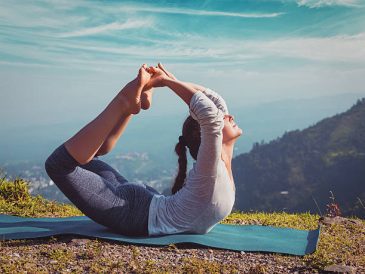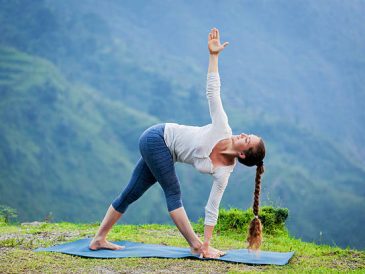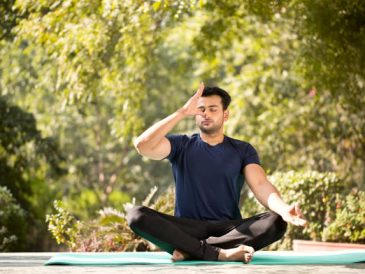Prashant reminds the students in the room as the class nears its end. All the windows in the hall are open. The outside is dark, and the heat of the day has not yet subsided. Although we appear to be sleeping, there is still much to absorb. I could have used any of the many phrases Prashant Ji uses to describe the dynamism at the Ramamani Iyengar Memorial Yoga Institute in Pune. I am incredibly fortunate to have recently returned from my first month-long experience at the Institute. While I am still in a liminal stage, here’s my “digestion” of the experience.
The Institute is called that for a good reason.
RIMYI was no exception. I have been fortunate in the past to attend masterclasses, intensive short courses, and other events designed to develop subject matter expertise. You can see practitioners implementing their ethos every day. The leaders are dedicated to the practice of Yoga. RIMYI is a place where the families who live on-site are also able to earn a living. The bhaji-wala brings fresh fruit and vegetables to the residence of the family every day as international students arrive and depart. As the domestic chores and daily rituals are carried out, we study. The children play games under the hall grills. Our lives progress in cycles that repeat, but we each have our unique pattern and duration. In this context, it was clear that I was merely ‘along for a ride’ in a much bigger narrative. It was my responsibility to listen and actively observe and to try to absorb the experience that was happening in real-time.
There is a lot to learn from the close to half a century of study of Yoga in this building. Sometimes, loudly and sometimes quietly, incorrect knowledge is challenged. The challenges are stated. You’re welcome to join us if you are here for Yoga. We are all students of a vast, ancient body of knowledge. RIMYI offers a unique opportunity to interact with people who are so dedicated to their work. This constant focus is also a source of confusion – at least for myself! So, sometimes, I had to admit that I was out of my element despite all my efforts. I could also laugh, knowing that Patanjali’s’ Sutra II.47, which is often referred to by many people, was still several lifetimes from me. BKS Iyengar in Light on Yoga Sutras, Patanjali: “Perfection is achieved when an asana becomes effortless. The infinite being within you is attained.”
Yoga is a philosophy, science, and art.
Many people are familiar with this phraseology from Iyengar yoga, so watching these three intertwined lines in action was fascinating. RIMYI offers learning development in a wide range of modalities and even bilingually. The daily schedule includes one class per day (five asanas, one pranayama), plus a self-practice session each day. On Sunday mornings, a class for children is held. Students can watch and enjoy the class. Children and teenagers can easily move from Adho Mukha Svanasana to Virasana, to Ustrasana, and from Dhanurasana to Parsva Dhanurasana, and finally into Urdhva Dhanurasana. Over and over!
We, as students, have our tasks to complete in class. As an example, in our asana class, we are asked to respond and experiment with the current situation. We ask questions like: “What did you notice today?” “What knowledge has it brought you now?” “How is it different than last time?” and so on. The classroom is a lab where we all have a part to play. Guriji’s photographs are displayed on the walls, and they are often referred to as if they were the Periodic Table of Elements. Look at his straight leg!
You can also watch historical films, such as one from a convention held overseas (in which students were wearing colorful yoga leotards that dated back to the late 1980s). There are also Geeta Ji’s recorded sessions to follow, as well as lectures. Srineet Sridharan, BKS Iyengar’s’ grandson, invited us, for example, to study Samkhya and its relation to Yoga. It’s a pleasure to be able to thank him personally for the extensive online Yoga Sutras of Patanjali lecture series that he and Prashant Ji have created. Teachers demonstrated how Viparita Karan can be done in a variety of ways. The next day, we put this theory to practice in a 2-hour class on back-bending.
The interior and architecture of the space also demonstrate ‘design thinking,’ which goes beyond aesthetics. The vast array of props, both known and unknown in their purpose, is “divine,” as Dr. Naik, the teacher, says. I arrived early and was able to spend quiet time examining the artworks, historical archives, photographs, and Hindu statues. By climbing to the roof, I was able to get a close-up view of the snake’s hood.
Self-reflection and self-practice within the collective.
Anne O’Brien wrote, “Yoga is full of paradoxes. The deeply personal, individual yoga practice is at the time a collective exploration.” (Iyengar, The Yoga Master edited by Kofi Buzia, 2007, p. 86). This book collection was published in Pune. I read the article, and it resonated with me at RIMYI. We know that you are the one on the mat. Raya Uma Dutta, a teacher, said at one time that sustained benefits from Yoga can only be gained by self-practice. He repeated this argument more explicitly because ‘dosage,’ as it is called in taught classes, will not always benefit everyone as our needs and demands are as varied as we all.
I was able to test these theories by doing self-practice sessions for 3 hours 4 days a week. It was up to me what I did and why. “I’m here, what will I do?” I asked myself. Physically, the most important thing I learned was to stretch and look up more in order to lift my spine and draw it in, as well as make my trunk active. I also experimented mentally with different timings, both for the two-sided poses and for the whole session. You don’t need to focus on the time; move from one asana to another.
Solo. You’re surrounded by a larger RIMYI Community, even though you are a single entity. The RMIYI community includes local and international yoga students as well as the entire RMIYI staff, who work tirelessly to make sure that everything runs smoothly. The care shown is obvious. There are not only personal issues but also global problems that directly affect us. Students help other students, teachers support students, and people talk, console, and laugh in between sessions. Attendance at therapy classes is common. When and where necessary, special attention is given.
The ‘Beginners’ Orientation’ session was held by Mrinal Patel on a Sunday, shortly after I arrived at the Institute. Local students attended the event. The many aspects of studying Yoga together were discussed with warmth and depth. The session included a philosophy base, an overview of the asana sequence, and people’s reasons for attending. The tea and veg-pastries (which I believe were from Santosh Bakery), which were served at the end of the session, also helped! This is to say that I saw the collective spirit of Yoga in many different ways.
When I decided to come here alone, I didn’t know what to expect. I knew that many had done it before and over decades ago (when there was not as much advice available). Abhijata, the Head of RIMYI, reminded us during a practice that ‘firsts’ have their peculiarities. She was referring to this idea in relation to the development of staying in Asana and then progressing to more difficult Asana. Abhijata reminded me of what it was like to breathe for the first time when you enter Supta Virasana. It doesn’t matter what experience someone has; it will be their first. Of course, I made mistakes, both cross-cultural and general, that were not deliberate. I appreciated the caring and thoughtful responses to my many mistakes. RIMYI’s community element is a vital part of its success. However, I must warn you that the neighborhood/stray dogs weren’t always welcoming to me at 5:20 am on my way to the class. I still remember Dr. Naik’s’ joyous wisdom when he said, in one of his courses, “We humans bark like dogs when we should stretch like dogs!”
Keep your eyes open!
In India, I used to wear a bandage on my eyes after a few days of practicing. This was my way of calming my optic nerves. India is a rainbow jewel, and as someone who loves color, my eyes are always wide open.
Another jewel was also revealed this time. The ability to observe classes. Yoga observation is an invaluable gem. On some days, I watched up to three different lessons to learn about the teaching techniques and styles used by teachers and staff. You can tell that their expertise has been refined by repetition, feedback, practice, and reflection. Constantly evolving. I watched over 16 RIMYI instructors teach classes. Some of them more than once. It was also a great experience to see how students responded to the teacher’s instruction. It was fascinating to see how different people react to the same instructions in order to act. This gave me a better understanding of how each person processes instructions differently, depending on their body, what they hear, and how they interpret the message. It is wonderful that students accept RIMYI’s teaching methods. We were given this opportunity, and it was extremely valuable.
Teachers in many classes and therapy emphasized the importance of keeping your eyes open. When things got physical, and our bodies were ‘opened up’ to new directions, I saw and experienced how we would often close our eyes and turn inward when the situation became more intense. Teachers can literally see the internal reactions of students when they keep their eyes open. It is a way of checking if the person is ok and helps the student to ‘face’ their feelings. The phrase “Eyes Open” literally wakes us up to the situation.
What is RIMYI, and what does it mean?
What is the ‘closeness’ of Iyengar to Iyengar to ‘do Iyengar Yoga’? What changes have occurred in the experiential philosophy over time? Is it the norm today that most Iyengar teachers and students never meet or learn directly from Guruji or Geeta Ji, nor do their teachers? Was it always true that the Iyengar ethos was passed on by a larger and more committed group of people? What makes the ripple effect feel strong for some students and weaker for others as we experience it as individuals? What impact will (or has) the pandemic have on the continued dissemination of Iyengar Yoga?
I’ve heard a few people talk about the ‘changes” that are happening at RIMYI. It’s human nature, I believe, to create a mythology about special places. We try to figure out where we belong, why, or what makes an event special. I met people who had come many times over the years and gently reflected on how things have always changed. Listening to students describe what their repeated RIMYI experience has provided them. All perceptions are ultimately subjective. I don’t have a ‘baseline’ to compare the differences between this RIMYI and any other.
What I know is that my teacher prepared me well for the amazing experience at RIMYI. The dedication and perseverance of senior Australian teachers have allowed me and many others to be gradually introduced to concepts used by RIMYI. This was a welcome and reaffirming realization. I want to thank all the teachers who are committed to their work. The zeal that I felt I was exposed to by the amazing and dedicated RIMYI staff right here was also nourishing. One day, a student from the area wore a T-shirt that said “Yoga” in class. RIMYI is India’s most important gift to the rest of the world. If we are open to engaging, there is much to be gained. I hope to be back.
Jackie Ruddock visited RIMYI in October 2023.
Afterword:
Pune’s vegetarian food is a huge part of Prashant Ji’s “munching.” This is a busy, vibrant city. The city has a rich history of manufacturing, academics, and IT. Its population and size are similar to Sydney’s. A lot is going on! Being at RIMYI six days a week, from 7 am to 8 pm, with only a short break for lunch, made me very focused on where I would eat each day. Google Maps’ ‘Pure Veg near Me’ search function allowed me to explore the neighborhoods around my house, and I found so many wonderful restaurants (both for the staff and food). Even if you don’t consider yourself a foodie, the joy of a tasty, satisfying meal can’t be understated when you’re experiencing a new place.




